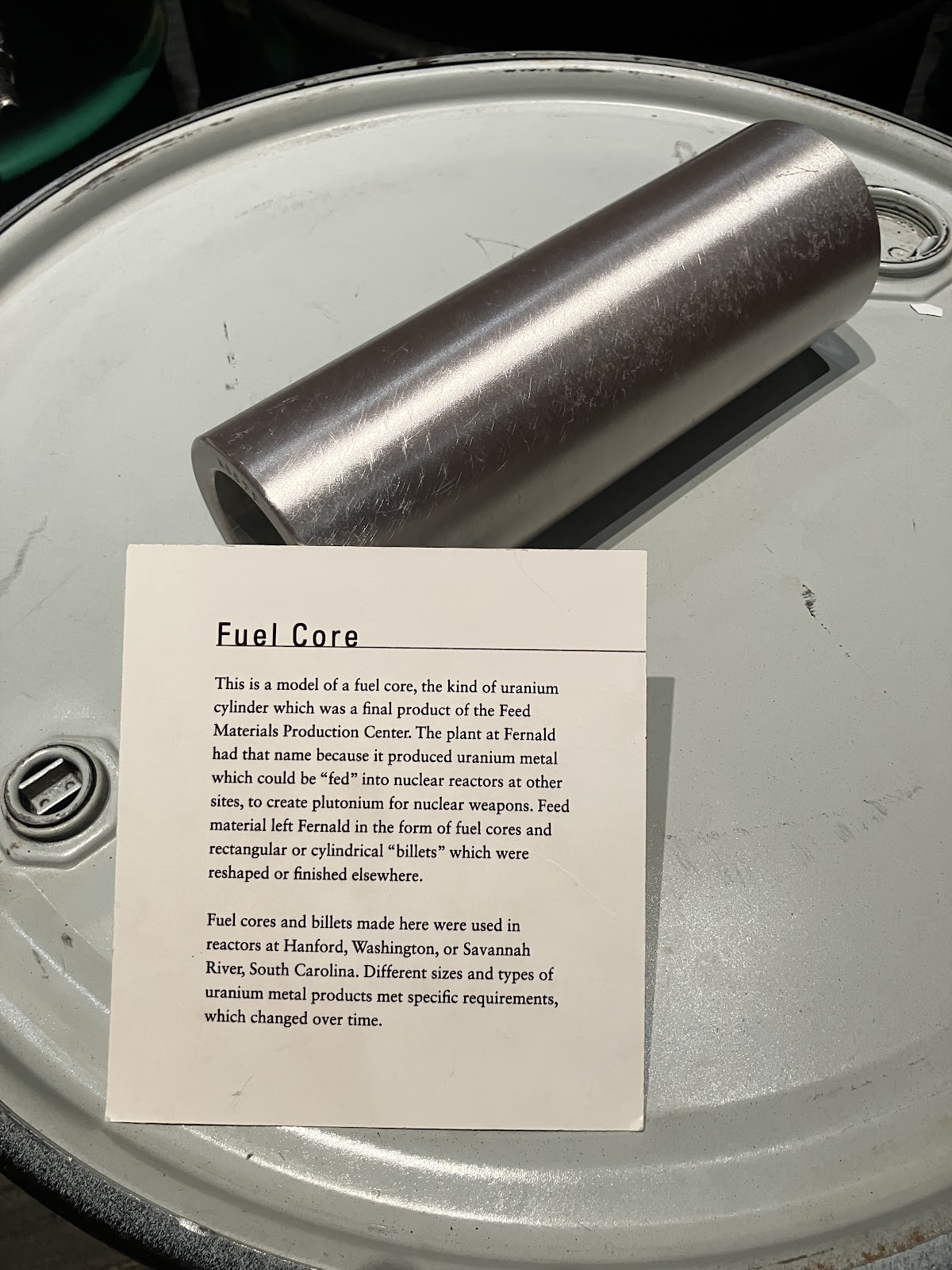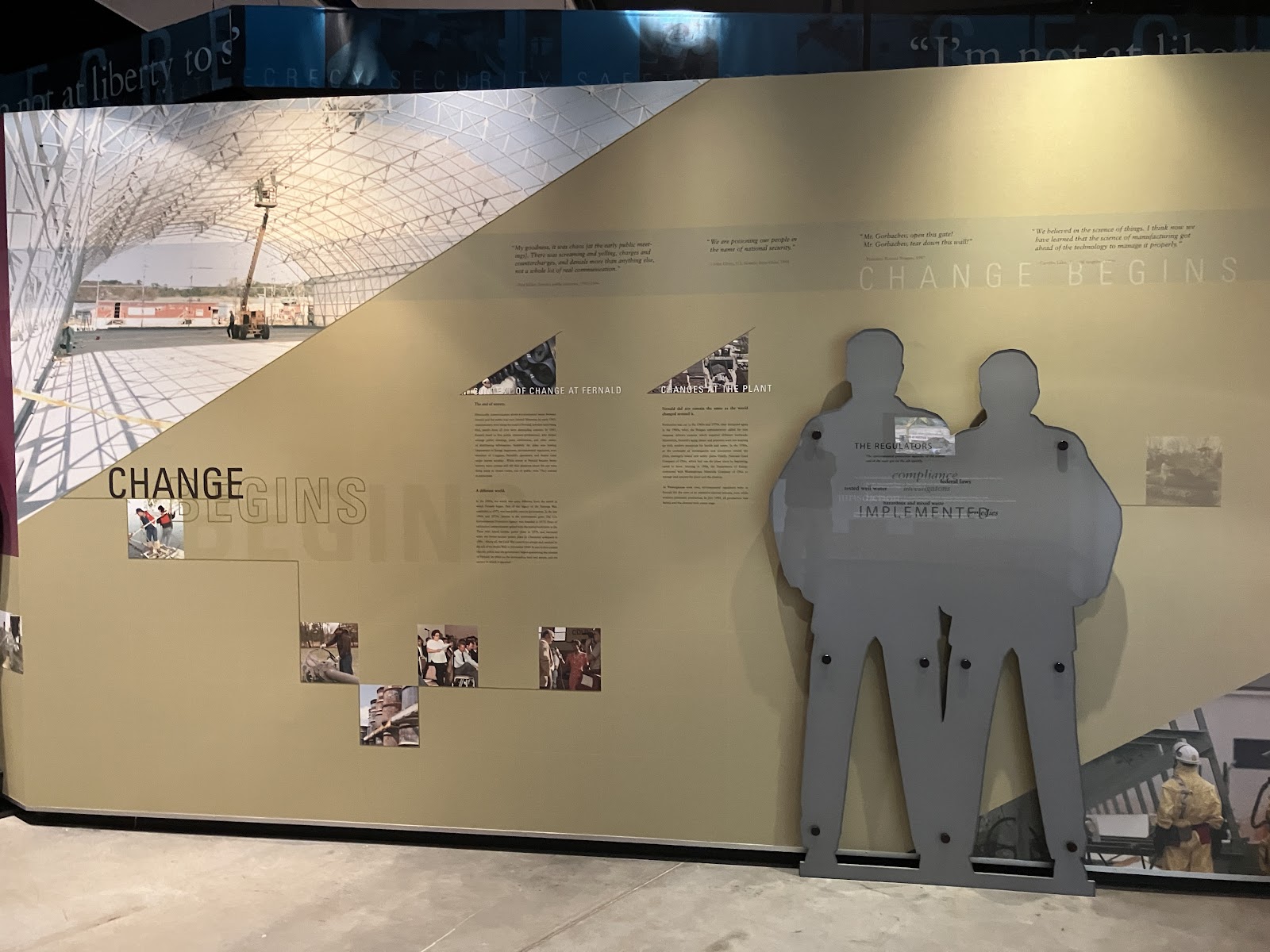This is a summary of photos
from two visits to the Fernald Preserve, 7400 Willey Road, Hamilton, Ohio, 45013.
The first visit was on August 7, 2011, after the preserve gates had opened but before the visitors center opened that day. The public entrance road on Willey Road has a stone sign for Fernald Preserve and a brass Ohio historical marker, "The First Link," about the Fernald Feed Materials Production Center.
"Ohio Historical Marker. The First Link: The Fernald Feed Materials Production Center initiated operations on this site in October 1951, in support of America's Cold War effort. As the first link in America's nuclear weapons production cycle, Fernald's mission was to produce high purity uranium metal products for use by other sites within the nuclear weapons complex. In the late 1980s, releases of radioactive contamination from Fernald focused national attention on the environmental legacy of the Cold War. As a result of reduced demand for its product and public outcry over the environmental contamination. Fernald's mission changed to environmental cleanup in 1989. Following the completion of one of the largest environmental cleanup and ecological restoration project in American history, the site was renamed "The Fernald Preserve" in 2006. U.S. Department of Energy, Fernald Preserve. 2008, The Ohio Historical Society, 74-31"
Shipping container for radioactive waste
Interpretive sign for Shingle Oak trail
West of the Fernald Preserve is the Willey Road bridge over Paddy's Run Creek, that collects surface water runoff from the area and then empties into the Great Miami River.

The second visit was on October 18, 2024 after the visitors center had opened. There is now an electric car charger with solar panels in the small parking lot near the visitors center door. The entrance hall is a large glass-walled open space with displays about the On Site Disposal Facility, the geology of the area, and the history of people in the area. While the actual On Site Disposal Facility can be seen out the east windows of the entrance hall, details of the OSDF are displayed by a large rectangular column in the middle of the entrance hall. One side lists the 13 layers of the disposal facility, top to bottom: vegetative layer, filter layer, biointrusion barrier layer, cover drainage layer, synthetic cap materials, compacted clay barrier layer, waste, protective layer, leachate collection system [LCS], primary geosynthetic liner system, leak detection system [LDS], secondary geosynthetic liner, compacted clay liner.
The history of the production
center is a series of rooms with video displays and a great deal of text on the
walls. This summary contains no video and many of the photos include text too
small to read. This summary is meant to provide an overview of the layout and
contents of the space with limited transcriptions of text in the photos. Please visit the Fernald Preserve and allow a couple of
hours to read all the text and view all the interactive exhibits.
The first section of wall is about land acquisition from the local farmers, the choice of the site being partly because it was close to a railroad, and some other displays I didn't photograph or remember. It might have been about the shallow ground water aquifer. The production center pumped a lot of water and I don't have any photos about that.
This entrance wall leads to a large room with walls about the cold war and the economic impact of the production center. There is an old television that plays Bert the Turtle as part of its display.
"Fernald's mission: an important step toward creating nuclear bombs as part of the American nuclear weapons complex. The Fernald plant played a key role near the beginning of the weapons-making process. The plant took in uranium ores and recycled uranium-bearing materials from other plants in the nuclear weapons complex, and from its own processing system. These materials were refined to a high purity, using chemical and metallurgical processes. The chief products of Fernald were uranium metals of various sorts which were 'fed' into systems at other sites where they became fuel for nuclear bombs. Since the metals were considered feed materials, Fernald was officially called the Feed Materials Production Center. Fernald was an essential link in the nuclear weapons complex which, at its peak, included 16 major sites, including vast reservations of land in Nevada, Tennessee, Idaho, Washington, and South Carolina. Few Americans outside those involved were aware of the scale of the complex, or the enormous effort involved in acquiring land, building factories, recruiting people, and coordinating so many diverse elements. Planning and design for the weapons took place in national laboratories established in New Mexico and California, with production of various components in Colorado, Florida, Missouri, Ohio, Tennessee, and Washington. Even now, long after some of the sites used in the nuclear enterprise have been turned over for other uses, the Department of Energy still owns 2.3 million acres of land and 120 million square feet of buildings."
The large cold war room is connected to a video room by a row of seven lockers. A rifle in a shadowbox is above the lockers with a fallout shelter sign above the right locker. In the center of the video room are several metal barrels with displays including models of a fuel core and a derby. The stools in the video room are small metal barrels with cushions.

The video room leads to the laboratory room with artifacts from the production center and descriptions and demonstration materials about radiation and monitoring. This room leads to a larger room that describes the secrecy and community at the production center. The exit from the secrecy room faces a video featuring Dan Rather, among others, reporting on the production center contamination. The video is the start of a large room describing the clean up of the site.
The secrecy room wall three
"December 1984 Fernald discloses the release of over 300 pounds of radioactive dust into the air. Department of Energy investigators found that wrong-sized dust bags had been used to replace worn ones. When the bags broke, radiation alarms sounded - but those who heard them at Fernald disregarded them, suspecting that the monitor was faulty. The incident made for intensive press coverage. Soon after, in 1985, the Ohio Environmental Protection Agency found contamination in ground water around the Fernald site. It turned out that the Department of Energy and National Lead Company of Ohio had known of the contamination, and had notified owners of three wells south of the site beginning in 1982. Well owners were told that the levels of radioactivity were within safe standards. However, the information did not become public until the 1985 announcement. Five hundred anxious neighbors and others turned out at a public meeting when the well locations were disclosed. Soon, other contamination problems made the news. In early 1986, Silos 1 and 2 were vented, releasing dangerous radon gas into the air. Next, the public read in the news that a vessel in the Pilot Plant designed to melt uranium compounds had developed a crack. Ohio Environmental Protection Agency scientists found that uranium from Fernald had definitely formed a large plume of contamination in the Great Miami Aquifer, which underlies the region. It was becoming clear that Fernald was polluting the environment and possibly endangering the health if workers and neighbors - and that the public had not been hearing the whole story. Authorities at the plant were hesitant to explain their actions to people or answer the press - largely because they were used to the federal laws and rules meant to keep weapons information secret and secure. A rising wave of news coverage, public outrage, and attention from all levels of government reached a peak in 1988."


Next to the production center history exhibit exit there is another large room with displays of wildlife that have moved into the Fernald Preserve (no photos). There are also many framed construction drawings from the production center. In one corner of this space is an exhibit about renewable energy at other DOE legacy management sites flanked by framed poster-sized factsheets of other DOE legacy management sites.
Corner exhibit of renewable energy at DOE Office of Legacy Management sites
First wall of DOE Office of Legacy Management poster factsheets
There is also a large meeting room. The whole visitors center is very nice and has lots of wildlife displays of which I did not get photos.














































